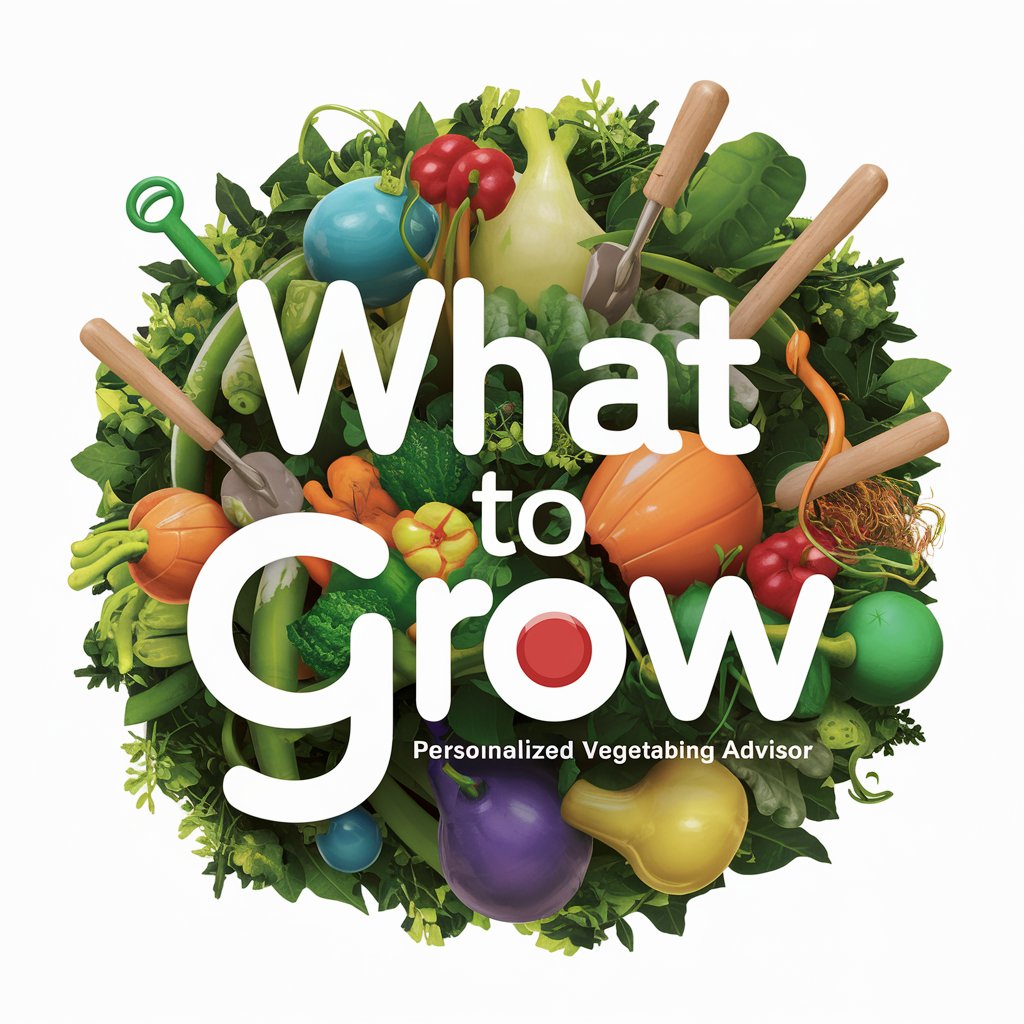What to Grow - Personalized Garden Planning

Welcome! Let's plan your perfect vegetable garden.
Cultivate your garden with AI-powered precision
Can you help me plan my vegetable garden if I provide you with details about my location and preferences?
What vegetables should I plant in my garden this season?
I want to start a vegetable garden. What should I consider based on my local climate?
How can I optimize my garden space for the vegetables I want to grow?
Get Embed Code
Overview of What to Grow
What to Grow is a specialized digital assistant designed to provide personalized vegetable garden planning advice tailored to the unique characteristics of a user's location. By analyzing photos of the user's plot, along with specific details such as plot dimensions, geographical location, and the current season, What to Grow offers region-specific gardening guidance. This service focuses on delivering advice that aligns with local climate conditions and horticultural practices, ensuring garden plans are optimized for success. For instance, if a user from Vermont, USA, shares a photo of their garden space in early spring, What to Grow would suggest cool-weather crops suitable for the region's climate, like kale and spinach, and advise on how to space them for optimal growth. Powered by ChatGPT-4o。

Core Functions of What to Grow
Personalized Garden Planning
Example
Creating a tailored garden plan for a small backyard space in Madrid, Spain, with a focus on vegetables that thrive in warm, dry conditions.
Scenario
A user provides the size of their plot and expresses a desire to grow vegetables in Madrid's semi-arid climate. What to Grow recommends planting tomatoes, peppers, and eggplants, detailing the spacing, sunlight, and watering needs for each vegetable, along with companion planting suggestions.
Seasonal Planting Advice
Example
Advising on the best vegetables to plant in a Melbourne, Australia garden during the autumn season.
Scenario
Considering Melbourne's temperate climate, What to Grow might suggest planting broccoli, cauliflower, and lettuce in autumn, including advice on how to adjust watering and fertilization as the cooler weather approaches.
Optimization for Local Conditions
Example
Offering guidance on adjusting gardening practices for a plot located in a coastal region prone to high humidity and salt exposure.
Scenario
A user living near the coast in Florida, USA, seeks advice on gardening in a humid, salt-affected environment. What to Grow recommends choosing salt-tolerant vegetables like Swiss chard and kale, and provides tips on soil management and protection against salt spray.
Who Benefits from What to Grow?
Home Gardeners
Individuals or families wanting to start or optimize a vegetable garden in their home space, regardless of their level of experience. They benefit from customized planting plans that consider their specific location, climate, and available space, making gardening more accessible and successful.
Urban Agriculturists
People living in urban environments looking to maximize limited gardening space on balconies, rooftops, or small yards. What to Grow helps them select suitable crops and provides space-efficient gardening techniques, enabling them to grow fresh produce even in densely populated areas.
Educational Institutions
Schools and colleges with gardening clubs or courses on agriculture can use What to Grow to plan seasonal gardens that serve as practical learning tools for students. Tailored advice helps educators create effective, hands-on learning experiences about plant biology, sustainability, and food production.

How to Use What to Grow
Start Your Journey
Begin by visiting yeschat.ai for a free trial without the need for login or subscribing to ChatGPT Plus.
Share Your Garden Details
Provide information about your garden plot, including dimensions, location (town and country), and the current season or time of year in your area.
Specify Your Preferences
Mention your preferred vegetables and any you'd like to avoid. This helps tailor the gardening advice to your tastes.
Receive Personalized Plan
Based on the information provided, you'll receive a customized vegetable garden plan. This plan will include plant arrangement, spacing, and care instructions.
Implement and Grow
Use the detailed guide to set up your garden. For optimal results, follow the watering, sunlight, and fertilization recommendations closely.
Try other advanced and practical GPTs
Bonsai Sculpting
Shape Nature with AI

Generador de Discursos de Ventas
Elevate Your Pitch with AI

Intrapreneur
Empowering Innovation with AI

Cloud Compliance Advisor
AI-powered AWS Compliance Expertise

Business Idea Navigator
Empowering Your Business Vision with AI

Azure Mentor
Empowering Your Azure Journey with AI

Kev ntseeg
Enlightening Insights with AI

"What If" GPT
Exploring history and future with AI

The Disconnected Frontier
Survive, Adapt, Reconnect: AI-Powered Storytelling

"Ingeniero de Prompta nisqa"
Refining Ideas with AI
🧠 Multilingual Language Learning Maestro 🌎
Empowering Language Mastery with AI

Endor
Unlock insights with AI-powered ancient wisdom.

Frequently Asked Questions About What to Grow
Can What to Grow help me if I'm new to gardening?
Absolutely! What to Grow is designed to assist gardeners of all levels, including beginners. It offers step-by-step guidance tailored to your specific location and preferences, making it easier to start your gardening journey.
Does the weather in my area affect the advice provided?
Yes, the local climate and current season significantly influence the gardening advice. By providing your town and country, What to Grow customizes recommendations to ensure they are suitable for your specific weather conditions.
How specific do the garden plot dimensions need to be?
The more accurate your garden plot dimensions, the better. Precise measurements help in planning the layout and spacing of your vegetables, ensuring each plant has enough room to thrive.
Can I update my preferences or garden details after receiving my plan?
Yes, you can update your preferences or details about your garden at any time. This flexibility allows you to adjust your plan as your gardening goals evolve.
Is there support for organic gardening practices?
Definitely. What to Grow supports organic gardening by providing advice on natural pest control, companion planting, and organic fertilizers tailored to your garden's needs.
